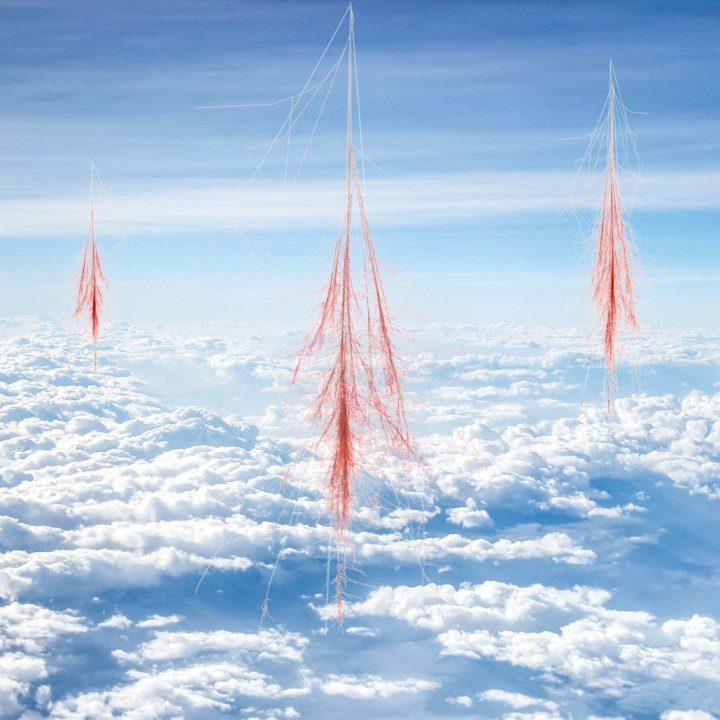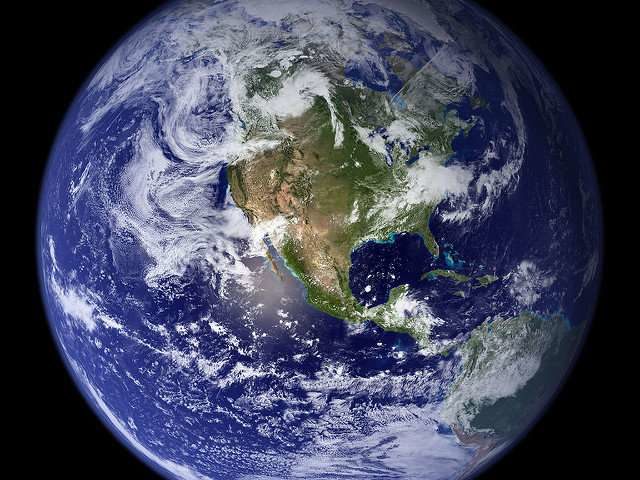"Den mest åbenbare måde hvorpå en opvarmning kunne ske naturligt, er for små naturlige svingninger i cirkulationsmønstret af atmosfæren og havene medførende en 1% eller 2% formindskelse af det globale skydække. Skyer er Jordens parasol, og hvis skydækket af en eller anden årsag ændres, så har du global opvarmning - eller global nedkøling."I dag har vi nyheder om noget som modulerer skydækket i et videnskabeligt papir af Henrik Svensmark i Nature Communications.
Kommentar: Denne artikel er delvis oversat til dansk af Sott.net fra: The 'missing link' between clouds, cosmic rays & climate change
PRESS RELEASE: DTU Space at the Technical University of Denmark
A breakthrough in the understanding of how cosmic rays from supernovae can influence Earth´s cloud cover and thereby climate is published today in the journal Nature Communications. The study reveals how atmospheric ions, produced by the energetic cosmic rays raining down through the atmosphere, helps the growth and formation of cloud condensation nuclei - the seeds necessary for forming clouds in the atmosphere. When the ionization in the atmosphere changes, the number of cloud condensation nuclei changes affecting the properties of clouds. More cloud condensation nuclei mean more clouds and a colder climate, and vice versa. Since clouds are essential for the amount of Solar energy reaching the surface of Earth the implications can be significant for our understanding of why climate has varied in the past and also for a future climate changes.

atmosphere and produces a cascade of secondary particles who ionize molecules when traveling through the air. One 100 GeV proton hits every square meter at the top of the atmosphere every second.
"Finally we have the last piece of the puzzle explaining how particles from space affect climate on Earth. It gives an understanding of how changes caused by Solar activity or by super nova activity can change climate."says Henrik Svensmark, from DTU Space at the Technical University of Denmark, lead author of the study. Co- authors are senior researcher Martin Bødker Enghoff (DTU Space), Professor Nir Shaviv (Hebrew University of Jerusalem), and Jacob Svensmark, (University of Copenhagen).
The new study
The fundamental new idea in the study is to include a contribution to growth of aerosols by the mass of the ions. Although the ions are not the most numerous constituents in the atmosphere the electro-magnetic interactions between ions and aerosols compensate for the scarcity and make fusion between ions and aerosols much more likely. Even at low ionization levels about 5% of the growth rate of aerosols is due to ions. In the case of a nearby super nova the effect can be more than 50% of the growth rate, which will have an impact on the clouds and the Earth's temperature.
To achieve the results a theoretical description of the interactions between ions and aerosols was formulated along with an expression for the growth rate of the aerosols. The ideas were then tested experimentally in a large cloud chamber. Due to experimental constraints caused by the presence of chamber walls, the change in growth rate that had to be measured was of the order 1%, which poses a high demand on stability during the experiments, and experiments were repeated up to 100 times in order to obtain a good signal relative to unwanted fluctuations. Data was taken over a period of 2 years with total 3100 hours of data sampling. The results of the experiments agreed with the theoretical predictions.
The hypothesis in a nutshell
- Cosmic rays, high-energy particles raining down from exploded stars, knock electrons out of air molecules. This produces ions, that is, positive and negative molecules in the atmosphere.
- The ions help aerosols - clusters of mainly sulphuric acid and water molecules - to form and become stable against evaporation. This process is called nucleation. The small aerosols need to grow nearly a million times in mass in order to have an effect on clouds.
- The second role of ions is that they accelerate the growth of the small aerosols into cloud condensation nuclei - seeds on which liquid water droplets form to make clouds. The more ions the more aerosols become cloud condensation nuclei. It is this second property of ions which is the new result published in Nature Communications.
- Low clouds made with liquid water droplets cool the Earth's surface.
- Variations in the Sun's magnetic activity alter the influx of cosmic rays to the Earth.
- When the Sun is lazy, magnetically speaking, there are more cosmic rays and more low clouds, and the world is cooler.
- When the Sun is active fewer cosmic rays reach the Earth and, with fewer low clouds, the world warms up.
- The implications of the study suggests that the mechanism can have affected:
- The climate changes observed during the 20th century
- The coolings and warmings of around 2°C that have occurred repeatedly over the past 10,000 years, as the Sun's activity and the cosmic ray influx have varied.
- The much larger variations of up to 10°C occurring as the Sun and Earth travel through the Galaxy visiting regions with varying numbers of exploding stars.
- Dr. Henrik Svensmark, Danish National Space Institute, in the Technical University of Denmark (DTU).
- Senior Resercher Martin Andres Bødker Enghoff, Danish National Space Institute, in the Technical University of Denmark (DTU).
- Professor Nir Shaviv, Physics Institute, Hebrew University of Jerusalem.
- Ph.D. student Jacob Svensmark, Dark Cosmology Center, University of Copenhagen.
H. Svensmark, M.B. Enghoff, N. Shaviv and J. Svensmark, Increased ionization supports growth of aerosols into cloud condensation nuclei, Nature Communications DOI: 10.1038/s41467-017-02082-2
The paper is here https://www.nature.com/articles/s41467-017-02082-2
Abstract:
Increased ionization supports growth of aerosols into cloud condensation nuclei
H. Svensmark 1, M.B. Enghoff 1, N.J. Shaviv2 & J. Svensmark1,3
Ions produced by cosmic rays have been thought to influence aerosols and clouds. In this study, the effect of ionization on the growth of aerosols into cloud condensation nuclei is investigated theoretically and experimentally. We show that the mass-flux of small ions can constitute an important addition to the growth caused by condensation of neutral molecules. Under present atmospheric conditions the growth rate from ions can constitute several percent of the neutral growth rate. We performed experimental studies which quantify the effect of ions on the growth of aerosols between nucleation and sizes >20 nm and find good agreement with theory. Ion-induced condensation should be of importance not just in Earth's present day atmosphere for the growth of aerosols into cloud condensation nuclei under pristine marine conditions, but also under elevated atmospheric ionization caused by increased supernova activity.
From the discussion section of the paper:
This suggests that there are vast regions where conditions are such that the proposed mechanism could be important, i.e., where aerosols are nucleated in Inter-Tropical Convergence Zone and moved to regions where relative large variations ionization can be found. Here the aerosols could grow faster under the influence of ion condensation, and the perturbed growth rate will influence the survivability of the aerosols and thereby the resulting CCN density. Finally the aerosols are brought down and entrained into the marine boundary layer, where clouds properties are sensitive to the CCN density2.Further reading:
Although the above is on its own speculative, there are observations to further support the idea. On rare occasions the Sun ejects solar plasma (coronal mass ejections) that may pass Earth, with the effect that the cosmic ray flux decreases suddenly and stays low for a week or two. Such events, with a significant reduction in the cosmic rays flux, are called Forbush decreases, and can be used to test the link between cosmic ray ionization and clouds. A recent comprehensive study identified the strongest Forbush decreases, ranked them according to strength, and discussed some of the controversies that have surrounded this subject.
Atmospheric data consisted of three independent cloud satellite data sets and one data set for aerosols. A clear response to the five strongest Forbush decreases was seen in both aerosols and all low cloud data. The global average response time from the change in ionization to the change in clouds was ~7 days, consistent with the above growth rate of ~0.4 nm h−1. The five strongest Forbush decreases (with ionization changes comparable to those observed over a solar cycle) exhibited inferred aerosol changes and cloud micro-physics changes of the order ~2%7. The range of ion production in the atmosphere varies between 2 and 35 ions pairs s−1 cm−337 and from Fig. 1b it can be inferred from that a 20% variation in the ion production can impact the growth rate in the range 1-4% (under the pristine conditions). It is suggested that such changes in the growth rate can explain the ~2% changes in clouds and aerosol change observed during Forbush decreases.
It should be stressed that there is not just one effect of CCN on clouds, but that the impact will depend on regional differences and cloud types. In regions with a relative high number of CCN the presented effect will be small, in addition the effect on convective clouds and on ice clouds is expected to be negligible. Additional CCNs can even result in fewer clouds. Since the ion condensation effect is largest for low SA concentrations and aerosol densities, the impact is believed to be largest in marine stratus clouds.
COSMIC RAYS, CLOUDS AND CLIMATE
Henrik Svensmark - DOI: 10.1051/epn/2015204
National Space Institute - Technical University of Denmark - Elektrovej, Bygning 328, 2800 Kgs - Lyngby, Denmark
The most profound questions with the most surprising answers are often the simplest to ask. One is: Why is the climate always changing? Historical and archaeological evidence of global warming and cooling that occurred long before the Industrial Revolution, require natural explanations.
Link to the PDF: SvensmarkEPN_46-2-2_2015




Læserkommentarer
dig vores Nyhedsbrev